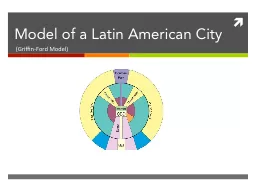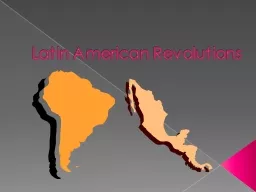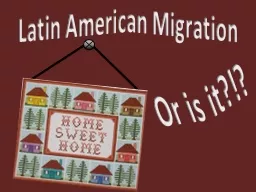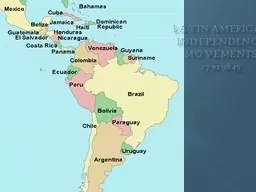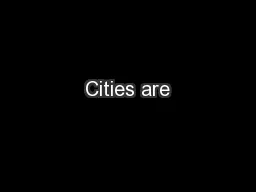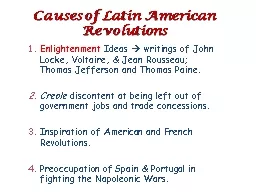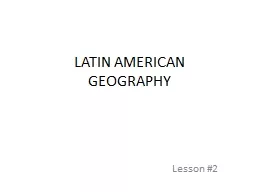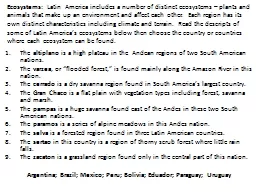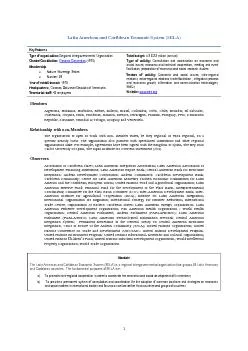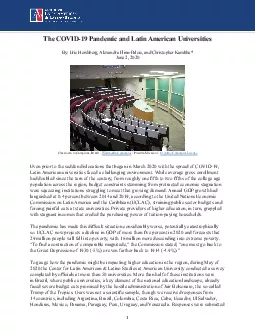PPT-Model of a Latin American City
Author : phoebe-click | Published Date : 2018-11-02
GriffinFord Model History Latin American cities fell under the rule of Spain during the colonial era As such they all followed the same set of regulations and laws
Presentation Embed Code
Download Presentation
Download Presentation The PPT/PDF document "Model of a Latin American City" is the property of its rightful owner. Permission is granted to download and print the materials on this website for personal, non-commercial use only, and to display it on your personal computer provided you do not modify the materials and that you retain all copyright notices contained in the materials. By downloading content from our website, you accept the terms of this agreement.
Model of a Latin American City: Transcript
GriffinFord Model History Latin American cities fell under the rule of Spain during the colonial era As such they all followed the same set of regulations and laws known as the Laws of the Indies They allowed Spain to keep reign over its colonies One of the included requirements was for the cities to have a grid pattern established around a central plaza The wealthy lived near the plaza while the poor lived along the outskirts This would be the start of the similar patterns found in Latin American cities . All are great fun, a chance to sample local merchandise, and unrivaled opportunities see the magnificent kaleidoscope of the colors, cuisines and customs of Latin American culture on display. . Blue Team will create our own Latin American Festival in the Cafeteria on Friday Jan. 17. Create a tree map with 3 branches!. Title is “Revolutions in the Americas”. Branch #1 is “Haitian Revolution”. Branch #2 is “Mexican Revolution”. Branch #3 is “South American Revolution”. Or is it?!?. Migrating vs. Immigrating. To . migrate. means to move to another country. To . immigrate. means to leave one’s own country. In other words: I would . migrate. away from the United States, but would be . “. ¡Viva México!. ”. In This Unit, We Will…. Explore the geography of areas with Latin American music. Explore the instruments used in Latin American music. Listen to music from different Latin American cultures, populations, and religious groups. 1791-1845. Independence Movements in Latin America. European domination of Latin . America. Spread . of Enlightenment . ideas. American . and French . revolutions. Growth . of nationalism in Latin America. outposts of control for Europe. Catholicism. is the major religion. Colonies mirror their . mother countries. Wealth gained through . Mining precious metals. Viceroys. – royal officials who rule. Revolutions. Enlightenment. Ideas . writings of John Locke, Voltaire, & Jean Rousseau; Thomas Jefferson and Thomas Paine.. Creole. discontent at being left out of government jobs and trade concessions.. (1810 – 1825). AP World History Notes. Chapter 17. Spanish American Revolutions. Inspired by the North American, French, and Haitian Revolutions. Intellectuals had become familiar with ideas from the European Enlightenment. Victoria Kirgesner - . Latin teacher, Cuyahoga Falls High School. Image Citations. Anderson, L. (2013, January 20). Teaching. Retrieved from https://www.pinterest.com/pin/118289927684787167/. Cuyahoga Falls, Ohio. (n.d.). Retrieved from . Lesson #2. Earthquake Zones. Active Volcanoes. Physical Features. . Dense __________________ mixed with mountainous terrain and dry, arid lands. . Tropical Islands (Caribbean) . RAIN FOREST. Physical Features. The . altiplano. is a high plateau in the Andean regions of two South American nations.. The . varzea. , or “flooded forest,” is found mainly along the Amazon River in this nation.. The . cerrado. Presented at the . Latin American Biologics/Biosimilars Conference. Sao Paulo, Brazil. September 27, 2016. Harry L. Gewanter, MD, FAAP, FACR . Chairman, Alliance for Safe Biologic Medicines (ASBM). 1 nd Caribbean Economic System (SELA) Key features Type of organisation: Regional Intergovernmental Organi s ation Charter/Constitution: Panama Convention (1975) Membership Nature: Sovereign State Wikimedia Commons2from both public and private institutions We found evidence not only of substantial adverse and have yet to re-open two months later Nearly three quarters of them transitioned to som
Download Document
Here is the link to download the presentation.
"Model of a Latin American City"The content belongs to its owner. You may download and print it for personal use, without modification, and keep all copyright notices. By downloading, you agree to these terms.
Related Documents

